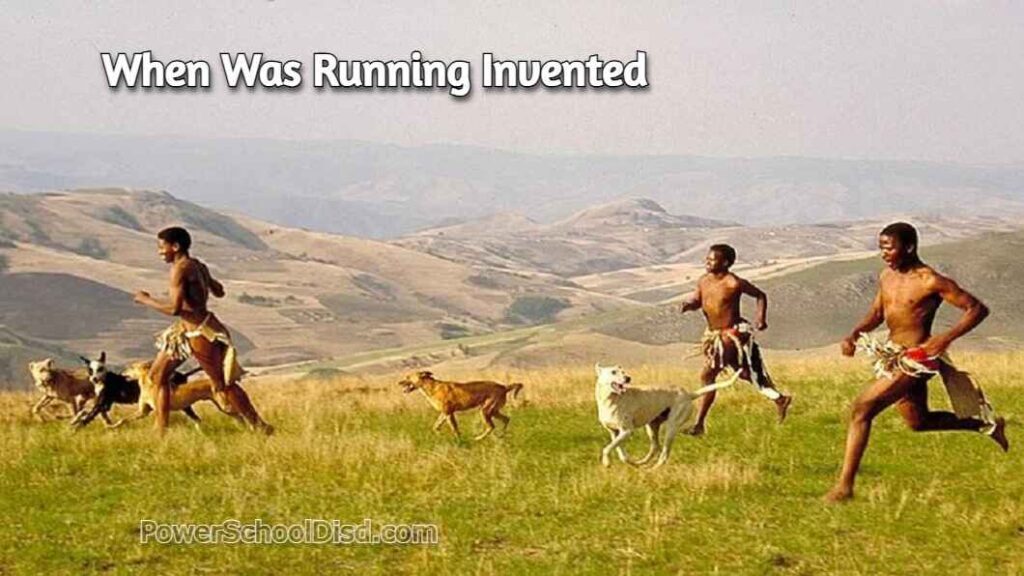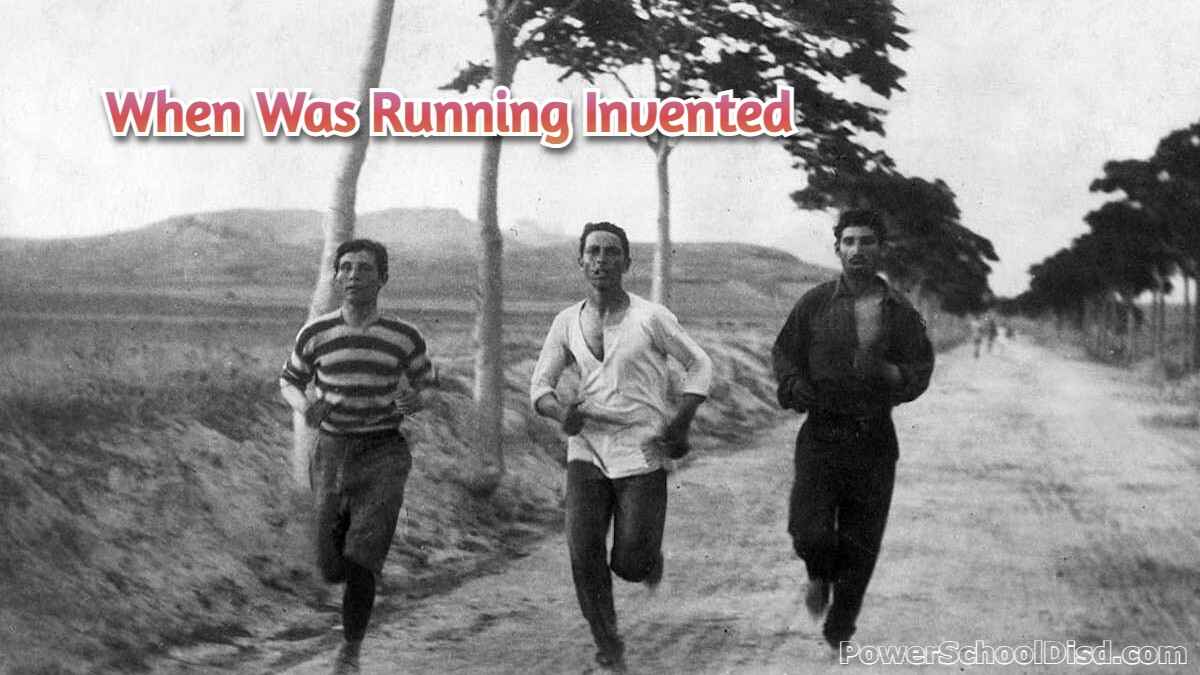
Introduction
When was running invented? This question seems simple, yet it holds a deeper historical and evolutionary context.
While humans have been running since the dawn of our species, understanding how running became a formalized practice both for survival and as a sport is a fascinating exploration of human history.
In this article, we will explore the roots of running, how it evolved, and when it transitioned into the competitive and recreational activity we know today.
The Ancient Origins of Running

When was running invented as a fundamental human skill? Running has been a part of human existence since early ancestors first walked upright.
Running, as an essential part of survival, was likely born out of the need to chase prey or flee predators. Before human civilizations, running was not a choice but a necessity.
As early humans began to evolve, so did their ability to run. The anatomical changes in the human body, such as longer legs and more efficient energy use, made running more feasible and effective.
For early humans, running was directly tied to survival, and it was a skill that could make the difference between life and death.
Running as a Survival Mechanism
Before it was formalized into a sport, running was purely a survival tool. Early humans had to chase down animals for food or escape dangerous predators.
Some anthropologists even suggest that early humans practiced “persistence hunting,” a technique where humans would run over long distances, wearing down their prey until the animal was exhausted and could be captured.
This survival tactic highlights how running was not just a physical action but a method of endurance and strategy.
Long-distance running allowed humans to tire out prey, which other animals, especially predators, could not do. This skill gave humans a distinct advantage and laid the foundation for later developments in running.
The Birth of Running as a Sport
So, when was running invented as a competitive sport? The practice of running as an organized sport can be traced back to ancient Greece.
The first recorded athletic competitions, where running races were featured, occurred during the ancient Olympic Games in 776 BC.
These races were central to the celebration of physical prowess and were seen as a way to honor the gods. The first Olympic Games were simple, with only one stadion, a short footrace of around 200 meters.
Over time, however, running competitions evolved, with longer races like the diaulos (400 meters) and the dolichos (long-distance race). This period marked the transition from running as a survival skill to running as a competitive sport.
Ancient Civilizations and Running Competitions

The Ancient Greeks were the pioneers of organized running events, setting the groundwork for modern competitive running.
They believed physical fitness was crucial to developing strong warriors and celebrated athleticism through festivals like the Olympics. These early Olympic Games featured various running events, which became integral to Greek culture and traditions.
Other civilizations also recognized the importance of running. In Ancient Rome, for example, chariot races were popular, but footraces were still part of public celebrations.
Running was valued for both its physical benefits and its symbolic role in honoring gods and showing off human capabilities.
Running in the Middle Ages: A Decline in Sport
After the fall of the Roman Empire, the formalization of athletic competitions, including running, slowed down significantly. During the Middle Ages, physical games and competitions were still prevalent but not as structured or popular as in ancient times.
Running races, if they existed at all, were mostly informal, localized competitions tied to religious events or celebrations. However, this period didn’t entirely stamp out the practice of running.
In cultures like the Norse or the Celtic tribes, athletic prowess, including running, was still respected, though not institutionalized as a formal sport. Running, like many physical activities, remained somewhat dormant until the modern age.
The Modern Revival of Running
When was running invented as we know it today? The modern era saw a resurgence of running as a structured sport. The late 19th century brought new levels of organization to competitive running, thanks to the revival of the modern Olympic Games.
In 1896, the modern Olympics introduced a marathon, bringing back the ancient Greek tradition of long-distance running. Along with the marathon, other races, such as sprints and middle-distance events, became part of the Olympic program.
The rise of track and field competitions during the 19th and 20th centuries in schools, colleges, and specialized athletics clubs helped establish running as an organized, global sport.
The Rise of the Marathon
One of the most iconic running events that emerged from ancient history is the marathon. Inspired by the legendary run of the Greek soldier Pheidippides, who ran from the battlefield of Marathon to Athens to announce the victory, the marathon became one of the most famous events in modern running.
The first marathon race, as we know it today, took place during the 1896 Olympic Games in Athens. The marathon’s distance, 26.2 miles (42.195 kilometers), became an emblem of endurance and human determination. The marathon remains one of the most prestigious events, attracting athletes from around the world.
Its modern significance lies not just in competition but in its symbolic representation of human strength and perseverance.
Running as a Global Fitness Movement

While running began as a competitive sport, it evolved into a fitness movement in the 20th century. By the 1960s and 1970s, running became synonymous with personal health, well-being, and fitness. Books like “Jogging” by Bill Bowerman and the creation of running clubs in the U.S. popularized running as a daily exercise routine.
The introduction of modern running shoes and more research on physical health contributed to making running safer and more comfortable. People no longer saw running as something only for athletes; it became a form of exercise that anyone could do to improve their health. The global running boom was born.
Running as an Accessible Sport
What makes running so unique is its accessibility. Unlike many other sports that require specialized equipment or facilities, running only requires a pair of shoes and a path.
This simplicity helped running to run rapidly worldwide. The sport’s popularity continued to grow throughout the 20th and 21st centuries, with cities around the world hosting marathons, 5Ks, 10Ks, and other running events.
Running became a universal activity, and it was practiced by people of all ages and backgrounds. From casual joggers to professional sprinters, running was now accessible to all.
The Role of Technology in Modern Running
The evolution of running didn’t stop with increased participation. In recent years, technology has revolutionized the sport.
GPS watches, fitness trackers, and running apps have allowed runners to track their performance, set goals, and measure their progress. These innovations have helped make running more data-driven, turning a simple activity into a personalized fitness journey.
Additionally, advancements in running gear such as high-tech shoes, moisture-wicking fabrics, and advanced sportswear have enhanced both comfort and performance for runners.
Technology has made it easier for runners to improve their form, prevent injuries, and optimize their training.
Running in the 21st Century: A Global Phenomenon
Today, running is not just about competition or fitness; it is a cultural phenomenon. Global marathons such as the New York City Marathon, Boston Marathon, and London Marathon attract hundreds of thousands of participants, while millions of people run for fun, fitness, and mental health every day.
Charity runs, obstacle courses, and ultra-distance races have expanded the scope of running, allowing participants to challenge themselves and contribute to causes they care about.
Running has become a celebration of physical and mental resilience, with events held year-round across the globe.
When Was Running Invented? The Answer

To answer the question, when was running invented, we must recognize that running, as an ability, has existed for millions of years.
It began as a survival tool for early humans and gradually evolved into a sport and a modern fitness activity. From ancient Greece to the modern marathon, running has been deeply intertwined with human history.
Running continues to evolve today, embracing technological advancements, and attracting millions of new participants.
Whether you are running for fitness, competition, or personal challenge, the history of running provides a rich backdrop to the transformative power of this simple yet profound human activity.
Conclusion
When was running invented? It was never truly “invented.” Instead, it evolved naturally as a fundamental human ability, used for survival, competition, and recreation throughout history.
From ancient survival tactics to the modern-day running boom, running is a testament to human endurance, strength, and perseverance. Today, it stands as one of the most accessible and universal forms of exercise, practiced by millions across the globe.
Running’s origins may be ancient, but its journey continues to inspire and empower people to push their limits and lead healthier lives.




